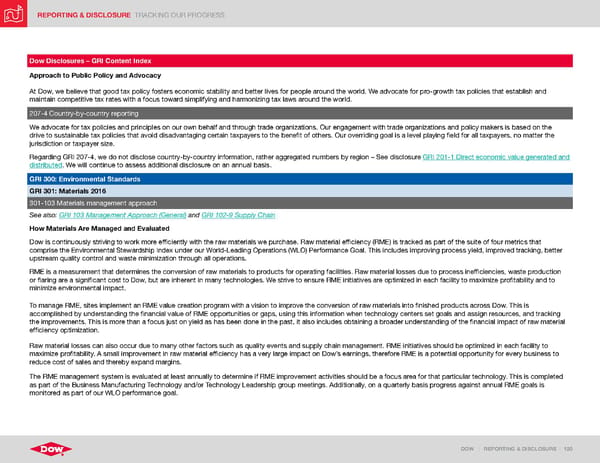REPORTING & DISCLOSURE TRACKING OUR PROGRESS DOW | REPORTING & DISCLOSURE | 120 Dow Disclosures – GRI Content Index Approach to Public Policy and Advocacy At Dow, we believe that good tax policy fosters economic stability and better lives for people around the world. We advocate for pro-growth tax policies that establish and maintain competitive tax rates with a focus toward simplifying and harmonizing tax laws around the world. 207-4 Country-by-country reporting We advocate for tax policies and principles on our own behalf and through trade organizations. Our engagement with trade organizations and policy makers is based on the drive to sustainable tax policies that avoid disadvantaging certain taxpayers to the benefit of others. Our overriding goal is a level playing field for all taxpayers, no matter the jurisdiction or taxpayer size. Regarding GRI 207-4, we do not disclose country-by-country information, rather aggregated numbers by region – See disclosure GRI 201-1 Direct economic value generated and distributed . We will continue to assess additional disclosure on an annual basis. GRI 300: Environmental Standards GRI 301: Materials 2016 301-103 Materials management approach See also: GRI 103 Management Approach (General) and GRI 102-9 Supply Chain How Materials Are Managed and Evaluated Dow is continuously striving to work more efficiently with the raw materials we purchase. Raw material efficiency (RME) is tracked as part of the suite of four metrics that comprise the Environmental Stewardship Index under our World-Leading Operations (WLO) Performance Goal. This includes improving process yield, improved tracking, better upstream quality control and waste minimization through all operations. RME is a measurement that determines the conversion of raw materials to products for operating facilities. Raw material losses due to process inefficiencies, waste production or flaring are a significant cost to Dow, but are inherent in many technologies. We strive to ensure RME initiatives are optimized in each facility to maximize profitability and to minimize environmental impact. To manage RME, sites implement an RME value creation program with a vision to improve the conversion of raw materials into finished products across Dow. This is accomplished by understanding the financial value of RME opportunities or gaps, using this information when technology centers set goals and assign resources, and tracking the improvements. This is more than a focus just on yield as has been done in the past, it also includes obtaining a broader understanding of the financial impact of raw material efficiency optimization. Raw material losses can also occur due to many other factors such as quality events and supply chain management. RME initiatives should be optimized in each facility to maximize profitability. A small improvement in raw material efficiency has a very large impact on Dow’s earnings, therefore RME is a potential opportunity for every business to reduce cost of sales and thereby expand margins. The RME management system is evaluated at least annually to determine if RME improvement activities should be a focus area for that particular technology. This is completed as part of the Business Manufacturing Technology and/or Technology Leadership group meetings. Additionally, on a quarterly basis progress against annual RME goals is monitored as part of our WLO performance goal.
 ESG Report | Dow Page 119 Page 121
ESG Report | Dow Page 119 Page 121